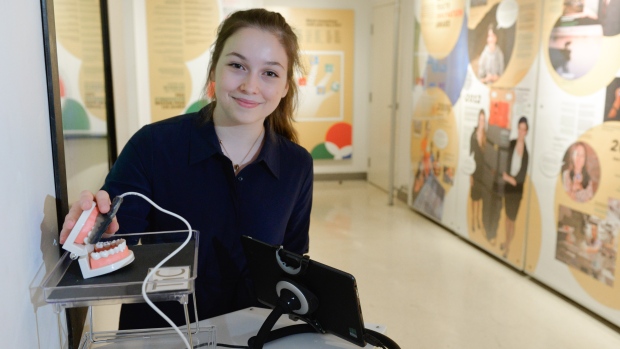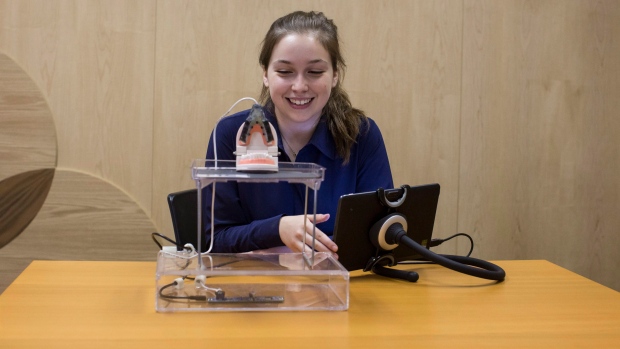Tongue-controlled computer mouse earns Ontario teen a science prize
Device is like having a mouse inside your mouth.

Emma Mogus says the device she created works by putting five buttons inside a mouthguard-type device. Each button corresponds to a different function: up, down, left, right, and enter. Ontario Science Centre
By Laura Wright, CBC News July 13, 2016
TORONTO — An Ontario teen has won a $2,000 science prize for creating and building a computer mouse that is controlled by the tongue.
Emma Mogus, 17, from Oakville, built the TiC, or Tongue-Interface-Communication. There are five buttons inside a mouthguard-type device, which is connected to a computer. Each button controls a different mouse direction.
“By using your tongue to press the centre button, for instance, it’s enter,” explains Mogus.
The other buttons are left, right, up and down.
“You can think of it as a mouse inside your mouth.”
Her invention won her the 2016 Weston Youth Innovation Award from the Ontario Science Centre.
Mogus said the TiC allows people with conditions that limit their physical movements — such as ALS, multiple sclerosis, and spinal cord injuries — to use computers.
And since many computers have on-screen keyboards, the person wearing it could also use the TiC to type out an email, or search for something on Google.
| Inspired by friend with ALS |
Mogus said her friend Tim, a husband and father who has ALS, inspired her to create the device. His wife told Mogus that he was having more and more difficulty communicating verbally.
She wanted to make some kind of device that would help. After some research, she found that the tongue is well-suited for helping people with physical disabilities.
“Your tongue is connected almost directly to your brain, so it nearly bypasses your entire spinal cord, so in these injuries your tongue is left unaffected,” she said.
Also, Mogus learned that the tongue doesn’t really get tired, and it’s capable of complex movement.

Emma Mogus, winner of the 2016 Weston Youth Innovation Award is pictured with her creation, the Tongue-Interface-Communication (TiC), a tongue controlled computer mouse, in Toronto on Wednesday, July 13, 2016. High School senior Mogus hopes to provide those with communication deficiencies and physical limitations the opportunity to participate fully in society. Chris Young, The Canadian Press
| Tested on herself and siblings |
She said there are other types of devices that help people with limited movement, but they’re not always ideal — some of them make use of a tongue piercing in the user, while others make use of breath and eye movement.
“But unfortunately they can be susceptible to involuntary movement, so it’s much easier to accidentally look a certain way or to breathe too heavily and to activate an undesired command.”
Mogus wanted to make something that would eliminate those errors.
The self-taught teen said it took her about three years to get to her latest prototype. She did a lot of testing on herself, and also bribed her younger siblings with candy to get them to test it.
“It uses a low voltage — it’s only 3.3 volts — so there’s no real risk [of getting injured]. But the tactile switches that are sticking out and kind of cutting the corner of your mouth — all these things I’ve learned along the way have led to my device today,” she said.
Her next step is to test with people like her friend, Tim, but she wants to wait until she’d done some more work on it. She’s looking into making the device wireless, and also into replacing the mouth guard with some kind of retainer.
She’s also researching patents, with the goal of making a product that’s affordable for those who need it.
![]() Source CBC News
Source CBC News
| References |
Qualitative assessment of Tongue Drive System by people with high-level spinal cord injury, Jeonghee Kim MS, Hangue Park MS, Joy Bruce MSPT PhD, Diane Rowles MS NP, Jaimee Holbrook MD, Beatrice Nardone MD PhD, Dennis P. West PhD, Anne E. Laumann MBChB MRCP (UK), Elliot Roth MD, Emir Veledar PhD, and Maysam Ghovanloo PhD. J Rehabil Res Dev. 2014; 51(3): 451–465. doi: 10.1682/JRRD.2013.08.0178
A Framework for Mouse and Keyboard Emulation in a Tongue Control System, Lund ME, Caltenco HA, Lontis ER, Christiensen HV, Bentsen B, Struijk LN. Conf Proc IEEE Eng Med Biol Soc. 2009;2009:815-8. doi: 10.1109/IEMBS.2009.5334055.
Noninvasive tongue-motion controlled computer mouse for the disabled, Chou CH, Hwang YS, Chen CC, Chen SC, Chou SW, Chen YL. Technol Health Care. 2016 May 18;24(3):401-8. doi: 10.3233/THC-161137.
Also see
Control a computer with your tongue Science News For Students
Tongue mouse: Cursor control with your mouth! Ben Krasnow
Tongue Drive: A brain-tongue-computer interface Georgia Tech Bionics Lab
